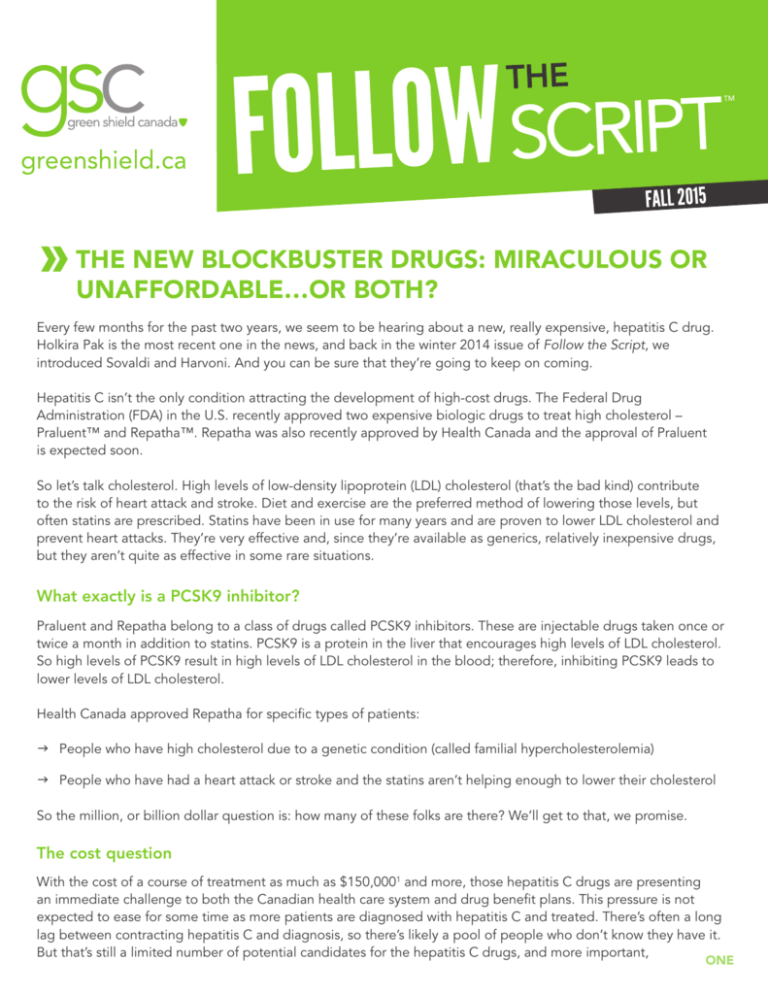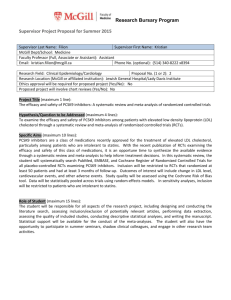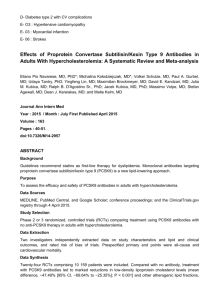THE NEW BLOCKBUSTER DRUGS: MIRACULOUS OR
advertisement

THE NEW BLOCKBUSTER DRUGS: MIRACULOUS OR UNAFFORDABLE…OR BOTH? Every few months for the past two years, we seem to be hearing about a new, really expensive, hepatitis C drug. Holkira Pak is the most recent one in the news, and back in the winter 2014 issue of Follow the Script, we introduced Sovaldi and Harvoni. And you can be sure that they’re going to keep on coming. Hepatitis C isn’t the only condition attracting the development of high-cost drugs. The Federal Drug Administration (FDA) in the U.S. recently approved two expensive biologic drugs to treat high cholesterol – Praluent™ and Repatha™. Repatha was also recently approved by Health Canada and the approval of Praluent is expected soon. So let’s talk cholesterol. High levels of low-density lipoprotein (LDL) cholesterol (that’s the bad kind) contribute to the risk of heart attack and stroke. Diet and exercise are the preferred method of lowering those levels, but often statins are prescribed. Statins have been in use for many years and are proven to lower LDL cholesterol and prevent heart attacks. They’re very effective and, since they’re available as generics, relatively inexpensive drugs, but they aren’t quite as effective in some rare situations. What exactly is a PCSK9 inhibitor? Praluent and Repatha belong to a class of drugs called PCSK9 inhibitors. These are injectable drugs taken once or twice a month in addition to statins. PCSK9 is a protein in the liver that encourages high levels of LDL cholesterol. So high levels of PCSK9 result in high levels of LDL cholesterol in the blood; therefore, inhibiting PCSK9 leads to lower levels of LDL cholesterol. Health Canada approved Repatha for specific types of patients: gg People who have high cholesterol due to a genetic condition (called familial hypercholesterolemia) gg People who have had a heart attack or stroke and the statins aren’t helping enough to lower their cholesterol So the million, or billion dollar question is: how many of these folks are there? We’ll get to that, we promise. The cost question With the cost of a course of treatment as much as $150,0001 and more, those hepatitis C drugs are presenting an immediate challenge to both the Canadian health care system and drug benefit plans. This pressure is not expected to ease for some time as more patients are diagnosed with hepatitis C and treated. There’s often a long lag between contracting hepatitis C and diagnosis, so there’s likely a pool of people who don’t know they have it. But that’s still a limited number of potential candidates for the hepatitis C drugs, and more important, ONE the hepatitis C drugs are a real cure, while many of the new drugs in development, like the PCSK9 inhibitors, are for chronic conditions and can be taken continuously over a lifetime. Many prognosticators see maintenance drugs that address common chronic conditions as having a far greater cost to the medical system than the hepatitis C drugs. High levels of LDL cholesterol is a common condition throughout North America, so there are millions of potential users of PCSK9 inhibitors who could be taking these drugs for a lifetime. In the U.S., Praluent is priced at US$14,600 per year and Repatha is US$14,100 per year.2 There are potentially as many as 10 million Americans who could qualify for PCSK9 inhibitors based on the indications approved by the FDA adding up to US$100B per year to the American health care system.3 Statistics Canada indicates that 40% of Canadians age 6-79 have high cholesterol4 which, when using the 2014 population data5, comes to more than 12.8 million Canadians who likely have high cholesterol. But the percentage of those people who fit the indications for these new drugs is quite small. So the number of Canadians who potentially could be prescribed PCSK9 inhibitors is estimated at about 370,0006. While we don’t know the cost of Praluent in Canada yet, Repatha is about CDN$7,300 per year, so an impact of about $2.7B per year can be estimated. Of course, the real challenge will come if these drugs are prescribed for a wider population, for instance those who experience side-effects from statins or anyone with high LDL cholesterol. Something else to keep in mind about new biologic drugs – like the PCSK9 inhibitors – when the patents expire, we won’t see cheap generics come on the market. Instead we’ll see subsequent-entry biologics (SEBs), which are not the same as generic drugs. Less expensive, but with nowhere near the savings as traditional generics. (See the fall 2014 issue of Follow the Script for a feature about biologics and SEBs.) Are the new biologics really that much better? The hepatitis C drugs are definitely better: they offer an actual cure in a limited number of doses and they’re well-tolerated. These drugs are a huge improvement over hepatitis C treatment from the past. The PCSK9 inhibitors are very new to the market, so it’s still too early to assess whether they will have the same kind of impact. Statins have been available for many years (since the late 1990s) and are proven to be effective at controlling high LDL and to lessen the rate of heart attack. Early studies have shown PCSK9 inhibitors to be better than statins at lowering LDL cholesterol. We reached out to Amgen Canada, the pharmaceutical company that created Repatha, and they told us that “…adding Repatha to existing cholesterol lowering therapy can reduce LDL-C levels by an additional 50-75% and that the majority (>90%) of patients on Repatha achieve their LDL-C reduction targets.” The bigger question is whether Praluent and Repatha are effective at preventing cardiovascular problems. Right now this is unknown and it will likely be two years or more before any conclusive data is revealed. So far PCSK9 inhibitors seem to be well tolerated, but again, it may also take time for side-effects to be evident. Coming down the drug pipeline We don’t have a crystal ball, but we can safely say that more biologic drugs are in our future. These will be high-cost drugs and while many are cancer drugs, others are in development for: Asthma Pain control – such as from osteoarthritis or back pain Rheumatoid arthritis Psoriasis Multiple sclerosis Alzheimer’s TWO HEPATITIS C CLAIMS AT GSC From 2013 to now, claims for all hepatitis C drugs combined increased by 189% and spend increased by 424%. In 2014/15, Sovaldi and Harvoni combined for 75% of all hepatitis C drug claims and 94% of the hepatitis C drug spend. Utilization for two older hepatitis C drugs – Incivek and Victrelis – went from 20% of all hepatitis C claims in 2013/14 down to less than 1% in 2014/15; the manufacturers have now discontinued these drugs. It breaks down like this: Drug Share of hep C claims in 2013/14 Share of hep C claims in 2014/15 Increase in claims Share of hep C spend in 2013/14 Share of hep C spend in 2014/15 Increase in spend Sovaldi 21.2% 37.6% 411% 44.8% 44.5% 420% Harvoni* 0% 37.3% 100% 0% 49.2 100% Incivek 3.9% 0% -100% 9.5% 0% -100% Victrelis 20.3% 0.7% -90% 22.2% 0.5% -89% Interferon 54% 11.3% -40% 22.3% 2.5% -40% *Introduced to market in late 2014. Should you be worried about the impact on your benefits plan? Regarding PCSK9 inhibitors, probably not (at least in the immediate future). Amgen Canada’s position is that “there is no need to panic. Existing cholesterol-lowering therapies are highly effective for the great majority of patients with high cholesterol. However, for patients who cannot achieve LDL-C targets with existing drugs and who remain at high risk of a cardiovascular event, Repatha is a new treatment option. The economic burden of cardiovascular disease in terms of lost productivity, short- and long-term disability is enormous and continues to grow.” In doing some preliminary cost-impact analyses, GSC has looked at other disease states (such as rheumatoid arthritis) where traditional therapies co-exist with costlier biologic drugs. Typically the proportion of plan members using more expensive therapies is less than two per cent, and this is taking into account that biologic therapy has been available for years. If we assume the same level of adoption of PCSK9 inhibitors, we should see moderate first-year impacts. Yet, these impacts will likely grow as physicians increasingly get accustomed to these new therapies and more indications are possibly approved. As we have been preaching in our health studies and publications, when considering the impact of high-cost specialty drugs on your benefits plan, you need to look at your total health spend, not just the amount spent on drugs. Consider the savings you achieve in other areas as plan members are cured of hepatitis C or lower their LDL cholesterol and don’t have a heart attack or other cardiovascular problems. Arguably, this is where you want to spend your benefit dollars – it’s what insurance is for – amazing, breakthrough drugs. Or you can spend on massages for dependents. There we go again… THREE Making those choices isn’t easy, we know that. GSC has always provided our plan sponsors with innovative programs to help manage costly expenses. Our prior authorization process and specialty drug preferred pharmacy network are designed to help protect your drug plan from the high cost of drugs like PCSK9 inhibitors – so plan members get the right drug, at the right time, for the best cost possible. And we are preachers of, and the with the Change4Life health portal, “reminderers” of drug adherence, in the hope drugs that are prescribed, expensive or inexpensive, are properly taken so precious program dollars are not wasted. As you have read, we are entering an incredible time for life-altering treatments but a challenging one for managing health program costs. We hope Follow the Script provides you with up to the moment “intel” to consider how benefit plans can balance the amazing with the expensive. Sources: 1 “Provinces update formularies to include hepatitis C treatments,” staff, Benefits Canada, July 29, 2015: http://www.benefitscanada.com/benefits/health-benefits/provinces-update-formularies-to-include-hepatitis-c-treatments-69781. Retrieved: July 29, 2015. “Independent group finds new cholesterol drugs far too costly,” Bill Berkrot, Reuters, September 8, 2015: http://www.reuters.com/article/2015/09/08/us-drugs-cholesterol-prices-idUSKCN0R82QY20150908. Retrieved: September 9, 2015. 2 “Breakthough cholesterol drug from Sanofi, Regeneron will sell for over $14,000 a year,” Matthew Perrone, The Associated Press, July 24, 2015: http://www.680news.com/2015/07/24/fda-approves-highly-anticipated-cholesterol-drug-amid-questions-of-cost-long-term-benefit/. Retrieved: August 12, 2015. 3 Statistics Canada, Cholesterol levels of Canadians, 2009 to 2011, http://www.statcan.gc.ca/pub/82-625-x/2012001/article/11732-eng.htm. Retrieved: August 12, 2015. 4 Statistics Canada, Canada’s population estimates: Age and sex, 2014, http://www.statcan.gc.ca/daily-quotidien/140926/dq140926b-eng.htm. Retrieved September 14, 2015. 5 “Trends in Medication Management 2015,” Telus Health Drug Conference, March 25, 2015: https://www.telushealth.co/page/wp-content/uploads/2015/03/telushealth_conference2015_02-vincent-ng.pdf. Retrieved: August 25, 2015. 6 FOUR INFUSION CLINICS In each issue of Follow the Script, we interview a member of our pharmacy team about a current topic. In this issue, GSC pharmacist Sal Cimino raises the issue of the lack of oversight for infusion clinics. FtS: Welcome back, Sal. You wanted to talk to us about infusion clinics, but first, what exactly are they? Sal: They’re medical clinics located outside of a hospital setting that provide intravenous infusion of drugs. FtS: I thought these kinds of drugs would be administered in a hospital. Can you give us a bit of background about these clinics? Sal: Before 2005 there were no infusion clinics – any drug that needed to be infused was administered in the hospital. The standalone clinics started appearing to infuse cancer drugs; these clinics were set up by doctors who saw a need for a more efficient way to get these drugs to their patients. And when drugs for other diseases, like Remicade for rheumatoid arthritis and/or Crohn’s, emerged and they had to be infused, the clinics expanded to include these drugs. Now we’re seeing more and more of these clinics around – drug distributors and wholesalers are setting up chains of them across the country. FtS: Come 2015, what drugs are we talking about? Sal: Remicade is the most famous one and is often administered in these clinics, but there are a lot of other infusion drugs now like Lemtrada [for multiple sclerosis] and Soliris [it treats a rare blood disorder]. There are always lots of cancer drugs that need to be infused too. FtS: Are doctors administering the drugs at these clinics? Sal: It depends on the drugs involved. For some drugs, you have to have a physician on site when infusing the drug for safety reasons. Other drugs are fine to be infused by specially trained nurses. And usually a doctor is supervising the infusions although they’re not involved with the day-to-day running of the clinic. FIVE FtS: Are there any concerns about the proliferation of these clinics? Sal: There is no question they do a good job in getting drugs to people who need them. But they seem to have crept into the marketplace and expanded quickly without any regulatory oversight. Frankly, there are no regulations that apply to infusion clinics – no body is specifically responsible for them in any of the provinces. There are no requirements for accreditation – and no one seems concerned. FtS: Who should be the regulator? Sal: Although we are talking about drug infusion, the College of Pharmacists probably wouldn’t be the organization to regulate the clinics since the issue is in the act of infusion, not the drugs themselves. The College of Physicians and Surgeons seems to be a logical entity since doctors are often closely involved with the clinics. The public would have assurance of safety and best practices to ensure patients get the drugs in an appropriate, safe environment. And while we are using our publications like Follow the Script to publicize this issue, we have also started to advocate to provincial governments to consider the issue. FtS: Please let us know when progress is made. Thanks, Sal. SIX









